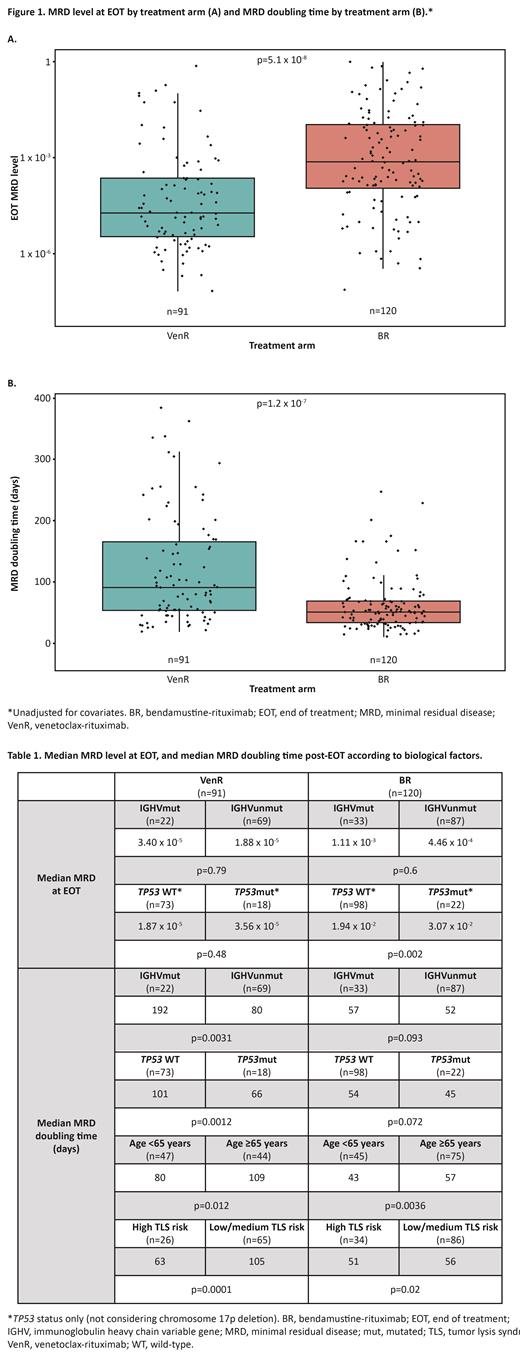Abstract
Introduction: At a median follow-up of 5 years (cutoff of May 8, 2020), the MURANO trial (NCT02005471) demonstrated deeper responses, including superior rates of undetectable (u)MRD and progression-free survival, in patients (pts) with relapsed/refractory (R/R) CLL treated with fixed-duration VenR vs bendamustine-rituximab (BR). With longitudinal MRD assessments in peripheral blood (PB), we now report kinetics of MRD growth after end of treatment (EOT), and the clinical and molecular factors associated with MRD growth rates.
Methods: Pts were randomized to VenR (venetoclax 400mg daily for 2 years + standard-dose rituximab for the first 6 months) or BR (6 months). PB MRD samples were collected every 3-6 months and analyzed centrally by allele-specific oligonucleotide-polymerase chain reaction and/or flow cytometry; uMRD threshold was <10 −4. Mutations were identified using whole-exome sequencing on available DNA specimens from CD19-enriched baseline samples.
For longitudinal analysis of MRD growth dynamics, a population-based logistic growth model with a nonlinear mixed effects approach was developed as previously described (Al-Sawaf et al. EHA 2021). Pts who completed treatment (Tx) without progressive disease (PD) and who had ≥2 measurable time points post-EOT were included; data below the lower limit of quantification in those pts was handled by a likelihood-based method (Bergstrand & Karlsson, AAPS J 2009). Prognostic markers and patient demographics were screened as covariates for impact on key model parameters, based on statistical and graphical assessments. Variables with >20% missing data or with low representation (<10% in any category) were excluded from the analysis. Statistical inference on MRD doubling time was derived for the stratified subgroups; all p-values are descriptive.
Results: Overall, 284 pts completed the study Tx without PD. Pts with no MRD data (n=23), pts with MRD data only on-Tx (n=6) or only after PD/next-line of Tx (n=2), or pts with <2 measurable MRD values (n=42) were excluded, leaving a total of 211 pts (91 VenR-treated and 120 BR-treated) included in the analysis. With a faster time to PD for the BR arm, median duration of MRD data collection post-EOT was 395 days for BR-treated pts and 735 days for VenR-treated pts.
The median MRD level at EOT was significantly lower after VenR (1.88 x 10 −5) than BR (7.06 x 10 −4; p=5.1 x 10 −8, Figure 1A). In the VenR arm, no statistically significant difference in median MRD level at EOT was seen in pts with mutated or unmutated immunoglobulin heavy chain variable gene (IGHV), or pts with or without TP53 mutation (Table 1). However, in the BR arm, pts with TP53 mutation had significantly higher median MRD levels at EOT than those with TP53 wild-type (Table 1).
Overall, median MRD doubling time post-EOT was significantly longer for pts treated with VenR (93 days; n=91) than BR (53 days; n=120; p=1.2 x 10 −7, Figure 1B). Based on covariate screening of 27 prognostic markers and patient demographics, age (< or ≥65 years), VenR Tx, IGHV status, TP53 mutation status, and disease burden at study initiation (low/medium risk of tumor lysis syndrome vs high risk) showed significant impact on MRD growth rate (Table 1). The median MRD doubling time was 53 days in pts aged <65 years (n=92) and 66 days in pts aged ≥65 years (n=119; p=0.013); similar differences were seen in both Tx arms (Table 1). After adjusting the other three covariates in the model, the effect of VenR Tx on MRD growth rate remained statistically significant (0.51-fold of that for the BR arm, 95% confidence interval, 0.41-0.64).
Conclusion: Using a robust, population-based model of MRD growth dynamics, we demonstrate that post-EOT MRD growth was slower in pts with R/R CLL treated with VenR compared with BR. Together with similar observations in the frontline setting of venetoclax-obinutuzumab Tx, these results suggest that, compared with chemoimmunotherapy, fixed-duration venetoclax plus anti-CD20 therapy may contribute to prolonged CLL disease control by slowing the growth of the residual disease clones. It also implies that clonal growth may be influenced by biological and Tx-related parameters. The underlying mechanisms need to be further explored.
Kater: Abbvie: Honoraria, Other: Ad Board, Research Funding; BMS, Roche/Genentech: Other: Ad Board, , Research Funding; Janssen, AstraZeneca: Other: Ad Board, steering committee, Research Funding; Genmab, LAVA: Other: Ad Board, Steering Committee. Lu: Genentech, Inc.: Current Employment; F. Hoffmann-La Roche Ltd: Current holder of individual stocks in a privately-held company. Langerak: Erasmus MS, University Medical Center: Current Employment; F. Hoffmann-La Roche Ltd/Genentech, Inc.: Research Funding; Gilead: Research Funding; Janssen: Speakers Bureau. Mellink: Cytogenetic Field: Consultancy; Genome Diagnostics Laboratory, AUMC: Current Employment; Financial support related to microarray analysis of Murano samples: Research Funding. Chyla: AbbVie: Current Employment, Current equity holder in publicly-traded company. Wu: Genentech, Inc.: Current Employment; Roche/GNE: Current equity holder in publicly-traded company, Current holder of individual stocks in a privately-held company, Current holder of stock options in a privately-held company. Boyer: Roche: Current Employment. Lefebure: F. Hoffmann-La Roche Ltd: Current equity holder in publicly-traded company; Roche: Current Employment. Jiang: F. Hoffmann-La Roche Ltd: Current equity holder in publicly-traded company; Genentech, Inc./F.Hoffmann-La Roche Ltd: Current Employment. Seymour: Sunesis: Honoraria, Membership on an entity's Board of Directors or advisory committees; Gilead: Honoraria, Membership on an entity's Board of Directors or advisory committees; Mei Pharma: Honoraria, Membership on an entity's Board of Directors or advisory committees; BMS: Honoraria, Membership on an entity's Board of Directors or advisory committees; Morphosys: Honoraria, Membership on an entity's Board of Directors or advisory committees; AstraZeneca: Honoraria, Membership on an entity's Board of Directors or advisory committees; Janssen: Honoraria, Membership on an entity's Board of Directors or advisory committees, Research Funding; AbbVie: Honoraria, Membership on an entity's Board of Directors or advisory committees, Research Funding, Speakers Bureau; F. Hoffmann-La Roche Ltd: Consultancy, Honoraria, Membership on an entity's Board of Directors or advisory committees, Research Funding, Speakers Bureau; Celgene: Consultancy, Research Funding, Speakers Bureau; Takeda: Honoraria, Membership on an entity's Board of Directors or advisory committees.


This feature is available to Subscribers Only
Sign In or Create an Account Close Modal